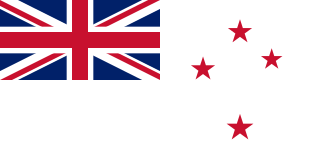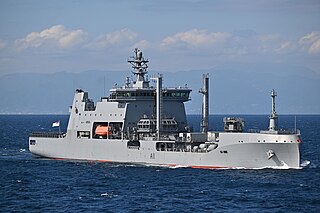A9, A.9, A09, A 9 or A-9 may refer to

The Royal New Zealand Navy is the maritime arm of the New Zealand Defence Force. The fleet currently consists of nine ships. The Navy had its origins in the Naval Defence Act 1913, and the subsequent acquisition of the cruiser HMS Philomel, which by 1921 had been moored in Auckland as a training ship. A slow buildup occurred during the interwar period, and then in December 1939 HMS Achilles fought alongside two other Royal Navy cruisers at the Battle of the River Plate against the German ship, Graf Spee.

HMNZS Resolution (A14) was a hydrographic ship of the Royal New Zealand Navy (RNZN). Originally the United States Naval Ship USNS Tenacious (T-AGOS-17), the Stalwart-class ocean surveillance ship was used by the United States to locate and track Soviet submarines from 1989 to 1997, when she was transferred to the RNZN for use as a hydrographic survey ship. She served until 27 April 2012. She was subsequently sold to EGS Group, a private surveying company, and renamed RV Geo Resolution.

HMNZS Wellington was a Leander-class frigate of the Royal Navy and the Royal New Zealand Navy (RNZN). Originally commissioned in 1969 for the Royal Navy as HMS Bacchante, she joined the RNZN in 1982. She was decommissioned in 1999 and sunk in 2005.

The Moa-class patrol boat was a class of patrol boats built between 1978 and 1985 for the Royal New Zealand Navy by the Whangarei Engineering and Construction Company. They were based on an Australian boat design.

HMNZS Wellington (P55) is a Protector-class offshore patrol vessel in the Royal New Zealand Navy.
HMNZS Tui, formerly USNS Charles H. Davis (T-AGOR-5), was one of nine Conrad class oceanographic ships built for the United States Navy (USN), that later saw service in the Royal New Zealand Navy (RNZN). Serving with the USN from 1963 to 1970, these ships were designed to perform acoustic experiments on sound transmission underwater, and for gravity, magnetism and deep-ocean floor studies.

HMNZS Endeavour (A11) was a fleet oiler for the Royal New Zealand Navy. She was named after James Cook's Bark Endeavour and the third ship in the RNZN to carry that name, though if continuity with the Royal Navy ships of the name HMS Endeavour is considered, she is the twelfth. The previous two ships of the RNZN were Antarctic research support vessels. Endeavour was built in South Korea to a commercial design and commissioned on 8 April 1988, and decommissioned on 15 December 2017.

HMNZS Kahu (A04) was a Moa-class inshore patrol vessel of the Royal New Zealand Navy. She was launched in 1979 as the lead boat of her class, modified to function as a diving tender. She was initially named HMNZS Manawanui (A09), the second of soon to be four diving tenders with this name to serve in the New Zealand Navy. As a diving tender she participated in the exploration and salvage work of the wreck MS Mikhail Lermontov in March 1986.
HMNZS Manawanui can refer to

HMNZS Canterbury (F421) was one of two broad beam Leander-class frigates operated by the Royal New Zealand Navy (RNZN) from 1971 to 2005. She was built in Scotland and launched in 1970. Commissioned in 1971, Canterbury saw operational service in much of Australasia and other regions like the Persian Gulf. She undertook operations such as supporting UN sanctions against Iraq and peace-keeping in East Timor. With her sister ship HMNZS Waikato she relieved the Royal Navy frigate HMS Amazon in the Indian Ocean during the Falklands War. Early in HMNZS Canterbury's career, in 1973, she relieved the frigate HMNZS Otago, as part of a unique, Anzac, naval operation or exercise at Moruroa during anti-nuclear protests, supported by a large RAN tanker, providing fuel and a large platform for Australian media. This was due to F 421 being a more modern RNZN frigate, with then current Rn surveillance radar and ESM and a more effectively insulated frigate from nuclear fallout, with the Improved Broad Beam Leander steam plant, for example, being remote controlled and capable of unmanned operation and therefore the ship provided a more effective sealed citadel for operations in areas of nuclear explosions.

HMNZS Philomel is the main administrative base of the Royal New Zealand Navy. Originally a training base on board the cruiser from which it takes its name, it is part of the Devonport Naval Base on the North Shore of Auckland, New Zealand.
HMNZS Manawanui was a naval tug which was modified for use as a diving tender by the Royal New Zealand Navy (RNZN). Originally intended for service with the United States Navy as a tug, the vessel was built in 1945 and transferred to the New Zealand Marine Department, which employed her in Waitemata Harbour before transferring the ship to the RNZN in 1948. She was converted to a diving tender in 1953 and served out her time in the RNZN in this role, before being decommissioned in 1978 and sold to the Paeroa Historic Maritime Park. The engine is now on display at the Whangarei Stationary Engine Club.
Cochrane Shipbuilders was a shipbuilder at Selby.

Operation Neptune was a programme of commemorative events and activities held in New Zealand throughout the year 2016 to celebrate the 75th anniversary of the establishment of the Royal New Zealand Navy in 1941.

HMNZS Aotearoa, formerly the Maritime Sustainment Capability project, is an auxiliary ship of the Royal New Zealand Navy. Builder Hyundai Heavy Industries delivered the ship to the Navy in June 2020, and she was commissioned into service on 29 July 2020. Full operational capability was expected to be achieved in 2021. The vessel serves as a replenishment oiler, and has replaced HMNZS Endeavour, the Navy’s last fleet oiler, which was decommissioned in December 2017.

HMNZS Manawanui was a dive and hydrographic vessel of the Royal New Zealand Navy (RNZN). It had previously served as the civilian survey vessel MV Edda Fonn in the Norwegian oil and gas industry. The ship was purchased for the RNZN in 2018, and commissioned on 7 June 2019, replacing the hydrographic survey ship HMNZS Resolution and diving support vessel HMNZS Manawanui (A09).

Recreational dive sites are specific places that recreational scuba divers go to enjoy the underwater environment or for training purposes. They include technical diving sites beyond the range generally accepted for recreational diving. In this context all diving done for recreational purposes is included. Professional diving tends to be done where the job is, and with the exception of diver training and leading groups of recreational divers, does not generally occur at specific sites chosen for their easy access, pleasant conditions or interesting features.

HMS Tamar is a Batch 2 River-class offshore patrol vessel of the Royal Navy. Named after the River Tamar in England, she is the fourth Batch 2 River-class vessel to be built and is forward deployed long-term to the Indo-Pacific region with her sister ship HMS Spey.














